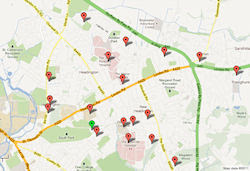London Road Improvements Stage 3
Meeting held at Headington Community Centre, Gladstone Road
12 December 2012
Background
After the work on Headington Road/London Road over the past few years Oxfordshire County Council plans to complete the upgrade of the London Road by carrying out improvements on the section from Bury Knowle Park to the Headington Roundabout. The Council has some £8m to spend on this and other related schemes. £5m comes from the Government under the ‘Local Sustainable Transport Fund’, the rest from developers and the County’s own capital spend.Their proposals for the London Road scheme should have been released for public consultation by now but have been delayed at least until March 2013. In an effort to keep local people informed County Councillor Roz Smith (LibDem, Barton & Churchill) arranged this informal meeting for the responsible County officer to explain the latest thinking. The meeting was not part of any official public consultation, which will happen in 2013. By my rough estimate over 50 people turned out at 6.30 on a freezing evening. Roz Smith explained the reason for the meeting and its status before introducing Owen South, Transport Planner from the County’s Transport Strategy Team.
Proposed improvements
Owen South outlined the problems the scheme is being designed to alleviate. These are principally to do with traffic congestion on this stretch of road, particularly in-bound (west-bound) at peak times. Before the in-bound bus lane starts at Gladstone Road buses stopping to pick up passengers (or drop off, in the case of London and airport coaches) can hold up other traffic – both cars and other buses – for several minutes. In the worst case this can mean traffic backs up to the roundabout and causes knock-on problems there. Outbound problems are not seen to be as bad. The County hopes that by reducing congestion bus travel times can be improved at peak times and people encouraged to use buses and alternative forms of transport instead of driving further into the City.
The preferred option at present is to extend the in-bound bus lane back to the roundabout but not to build an out-bound bus lane from Bury Knowle Park to the start of the bus lane which runs from near Gladstone Road almost to the roundabout. Creating a new in-bound bus lane would mean reducing the width of the pavement on the south side of the London Road over the corresponding stretch.
Discussion
I will post a link to the more formal record of the meeting when it’s available. What follows is my own version of events. If you were at the meeting and feel I’ve missed something important or misrepresented your contribution please leave a comment.
Almost everyone in the audience who spoke thought that the plan as outlined was flawed, inappropriate, or just wrong. There were three main themes.
- Safety. Speakers were concerned that reducing congestion meant higher traffic speeds, increasing the risk to both cyclists and pedestrians. Reducing the pavement width would mean less room where cycles and pedestrians share space, increasing the likelihood of accidents and also encouraging more cyclists to use the road (bus lane), which is more dangerous.
- Community. The point was made many times that the London Road is not just an arterial highway. People live in houses on and near the road; they need to walk along it and cross it to get to schools, shops, doctors, the park, library, etc. Nothing in the County’s plans seemed to recognise this or the desire of local residents to maintain or improve their quality of life.
- Relevance. The scheme seemed to be exclusively concerned with, and for the benefit of, buses and their passengers, including those travelling to and from London and the airports. It seemed to ignore other plans, for example the impact of the Barton West and Old Road campus developments, and encouragement of increased cycle use (eg cycle hire at Thornhill P&R). In my own words, it seemed to show a lack of joined-up thinking and risked becoming a missed opportunity to make a real improvement in this part of Headington. Bringing this scheme forward in isolation from the other plans covered by the Sustainable Transport funding (currently Thornhill P&R changes, walking & cycling facilities, and something called ‘Travel Choices’) seems misguided.
Owen South was rather at a disadvantage as he had drawn up the scheme (I assume it was ‘his’ project) according to the brief he’d been given. He defended it as best he could but it was plain that the collective view was that the brief was inadequate or just wrong.
The next stage is for the County to finalise a ‘preferred plan’ and approve its release for public consultation. It remains to be seen if the views from the meeting will have any influence over what emerges.
I should add that Shaun Hatton, the officer responsible for highway maintenance, was the other invited speaker. Time ran out and he didn’t get much chance to contribute, although some people managed to raise the familiar problem of road flooding.
[Update 15/12/12: No comments here but a lively response on the Headington & Marston e-democracy forum. The Oxford Times’ report of the meeting, with a slightly different slant, is here.]
